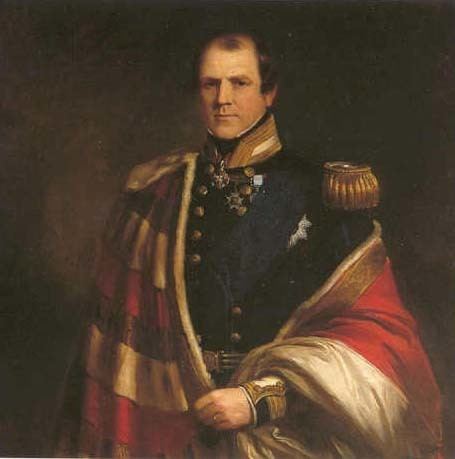Monarch Victoria Name Frederick 4th Monarch Victoria | Preceded by The Earl De La Warr Prime Minister Lord John Russell | |
 | ||
Succeeded by The Marquess of Breadalbane Prime Minister The Earl of AberdeenThe Viscount Palmerston Parents George Spencer, 2nd Earl Spencer Children Charles Spencer, 6th Earl Spencer, John Spencer, 5th Earl Spencer Siblings John Spencer, Viscount Althorp Similar People Charles Spencer - 6th Earl S, George Spencer - 2nd Earl, Albert Spencer - 7th Earl S, Georgiana Spencer - Countess, Cynthia Spencer - Countess | ||
Vice-Admiral Frederick Spencer, 4th Earl Spencer KG, CB, PC (14 April 1798 – 27 December 1857), styled The Honourable Frederick Spencer until 1845, was a British naval commander, courtier, and Whig politician. He initially served in the Royal Navy and fought in the Napoleonic Wars and the Greek War of Independence, eventually rising to the rank of Vice-Admiral. He succeeded his elder brother as Earl Spencer in 1845 and held political office as Lord Chamberlain of the Household between 1846 and 1848 and as Lord Steward of the Household between 1854 and 1857. In 1849 he was made a Knight of the Garter.
Contents
Through his second son, Charles, Lord Spencer was the 2nd great-grandfather of Diana, Princess of Wales, the 3rd great-grandfather of future British Monarch Prince William, Duke of Cambridge, and the 4th great-grandfather of William's son, Prince George.
Background and education
Spencer was born at the Admiralty Building, London, the fifth son of George Spencer, 2nd Earl Spencer, and Lady Lavinia Bingham, daughter of Charles Bingham, 1st Earl of Lucan. He was the younger brother of John Spencer, 3rd Earl Spencer. He was baptised in St Martin-in-the-Fields and educated at Eton from 1808 to 1811.
Naval career
Spencer then joined the Royal Navy as a midshipman on 18 September 1811, and fought in the Napoleonic Wars in the Mediterranean between 1811 and 1815. He served for a time under his brother, Captain the Hon. Robert Cavendish Spencer as a lieutenant aboard his ship HMS Owen Glendower, before receiving his own command, that of the brig HMS Alacrity on the South America Station. He was promoted to the rank of captain on 26 August 1822. During the Greek War of Independence he commanded HMS Talbot at the Battle of Navarino on 20 October 1827 and was appointed a Companion of the Order of the Bath in November of that year. The following year he fought with the Naval Brigade in the Morea expedition. For his actions he was made a Knight of the Order of St Louis of France and awarded the Order of St Anne of Russia and the Order of the Redeemer of Greece.
Political career
Spencer then retired from naval life and was elected Whig Member of Parliament for Worcestershire in 1831. He held this seat until 1832 and then represented Midhurst between 1832 and 1834 and again between 1837 and 1841. He was later an equerry in the household of the Duchess of Kent (Queen Victoria's mother) from 1840 to 1845. The latter year he succeeded his elder brother in the earldom and took his seat in the House of Lords.
When the Whigs came to power under Lord John Russell in 1846, Lord Spencer was appointed Lord Chamberlain of the Household. He was sworn of the Privy Council the same year. He resigned as Lord Chamberlain in 1848 but returned to the government as Lord Steward of the Household in early 1854 under Lord Aberdeen, a post he held until shortly before his death in 1857, the last two years under the premiership of Lord Palmerston. He was made a Knight of the Garter in 1849. He was also promoted to Rear-Admiral in 1852 and to Vice-Admiral (on the reserve list) in 1857.
Family
Lord Spencer was twice married. He married firstly his cousin, Georgiana Poyntz (1799–1851), on 23 February 1830. They had three children:
After Georgiana's death in 1851 he married secondly, Adelaide Horatia Seymour (1825–1877), daughter of Sir Horace Seymour and a great-granddaughter of Francis Seymour-Conway, 1st Marquess of Hertford, on 9 August 1854. They had two children:
Lord Spencer died at the family seat at Althorp, Brington, Northamptonshire, in December 1857, aged 59, and was succeeded in the earldom by his only son from his first marriage, John, who became a prominent Liberal politician. Spencer's son from his second marriage, Charles, who succeeded in the earldom in 1910, was also a successful Liberal politician. He was the great-great-grandfather of Diana, Princess of Wales. The Countess Spencer died at Guilsborough, Northamptonshire, in October 1877, aged 52.
